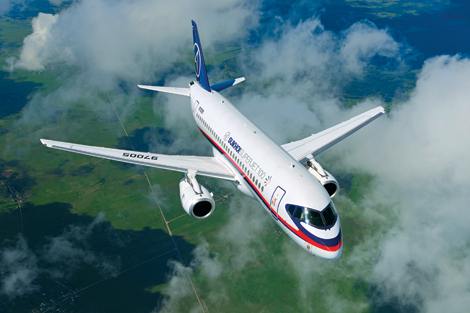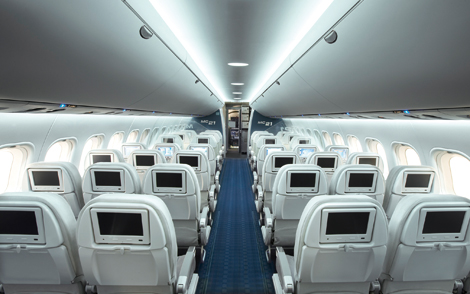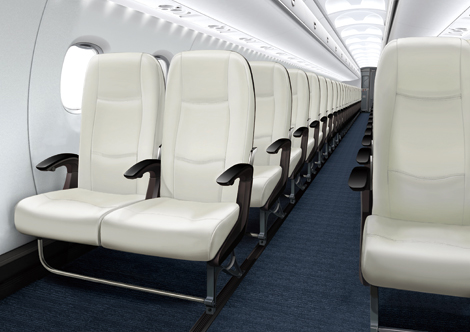Passenger demand the world over is on the rise. International Air Transport Association (IATA) projections suggest traffic will more than double in the next 18 years, from 2.9 billion passengers to 6.7 billion in 2032.
The Asia-Pacific region, slated for the steepest growth, represents a particular challenge as it is grappling with capacity issues and an over-reliance on traditional aircraft manufacturing powerhouses.
The two heavyweights, Airbus and Boeing, have held the reins of power in the medium- and large-aircraft segment for decades, while Bombardier and Embraer have been making a name for themselves since the 1990s.
But ordering new jets for growth and replacement is no easy feat, even if airlines have the money to pay for the multi-million dollar additions to their portfolios. Packed order backlogs can leave carriers waiting years for their new models to arrive.
Challenges present opportunities
The Asia-Pacific is a special place in the sense that nowhere else in the world has flying become so instrumental to people making their journeys from A to B. More people, greater wealth, bigger cities and an urban population set to grow from 52 per cent today to over 60 per cent within the next 15 years will only further the trend.
Emerging markets in the region, think Myanmar and Indonesia, equate to more first time flyers and a growing middle class that will grow from 2.2 billion today to 5.2 billion by 2030.
These figures are promising, yet at the same time, alarming. We have taken an in-depth look at new aircraft manufacturers from the Asia-Pacific that might be able to take some of the edge off the market’s high demand, with lesser-known regional aircraft projects currently underway in our backyard.
Go where the money is
Regional jets are the fastest-growing aircraft segment. Recent data suggests single-aisle jets will comprise 70 per cent of new aircraft deliveries in the next 20 years.
The regional jet’s hike in popularity is linked to the airlines’ on-going quest for the most fuel-efficient means of operation to feed traffic to their ever-larger hub-and-spoke systems. A hub-and-spoke system is a route network where an airline will not only plan to transport passengers between two points, but also connect passengers between two distant cities via its hub, which makes it more efficient because of route network simplification.
Air China, for instance, sends almost 80 per cent of its traffic through its hub at Beijing International Airport, whereas All Nippon Airways (ANA) does the same through its Tokyo Haneda and Narita hubs. Both carriers increasingly rely on smaller regional aircraft for this as a number of factors could stand in the way of deploying wide-body aircraft, such as insufficient passenger numbers and runway length restrictions.
As fuel prices continue to soar, carriers all over the world are looking for more economically viable and readily available options. Here are three manufacturers whose projects have the potential to change our airport landscapes of the future:
United Aircraft Corporation
Sukhoi Superjet 100
At Russia’s United Aircraft Corporation’s (UAC) Sukhoi subsidiary, two regional jetliner projects have taken precedence in recent years, underlining the country’s ambition to ascend to the world stage of passenger aircraft manufacturing.
First up was the Sukhoi Superjet 100 (SSJ100), which had its maiden flight in 2008, before being delivered to the now-defunct Armenian launch customer Armavia in 2011.
The SSJ 100 was originally to be produced in four variants, ranging from the shorter SSJ100/75 and SSJ100/75LR (long range) to the stretched SSJ100/95 and SSJ100/95LR. Until now, however, only the two longer variants have entered the skies and production for the SSJ100/75 and SSJ100/75LR has been shelved.
The two SSJ100/95 variants only differentiate from one another in terms of range. While the SSJ100/95 has a range of 3,048km (1,894miles), the SSJ100/95LR can cover distances of up to 4,578km (2,845miles), or roughly the equivalent of the six-hour Hong Kong to Mumbai flight.

The two variants’ fuselages are identical and offer room for up to 108 passengers in a dense 30-inch all-economy configuration. A more passenger-friendly 32-inch layout provides room for 98 passengers in an all-economy setup, while a two-class version includes a small business class section upfront and seats 86.
Russian flag carrier Aeroflot, currently the largest and internationally best known customer of the Superjet, operates the aircraft with an 87-seat arrangement – 12 business and 75 economy class – to several dozen destinations in Russia, Germany, Sweden, Poland, Denmark, Finland, Norway, Croatia, Romania, Latvia, Estonia, Ukraine and Belarus.
The SSJ100 has thus far found most of its buyers in Russia and the Russian-influenced economies of Central Asia. A notable exception is Mexico’s Interjet, which ordered 20 of the jets in 2011, with 10 already in service.
In the Asia-Pacific, the Russian government-subsidised Superjet has not attracted many customers. Indonesia’s Kartika Airlines initially ordered 50 SSJs but then had to cancel the thereto-largest order of the aircraft when it declared bankruptcy in 2010. Another Indonesian domestic airline, Sky Aviation, has ordered 12 frames, with three currently in active service.
Designed to compete internationally with Embraer’s and Bombardier’s counterparts, the Superjet claims substantially lower operating costs, at a lower purchase price of US$35 million. However, as this issue went to press only 29 SSJs have been delivered and 76 more are on order – hardly enough to call the programme a success.
Irkut MC-21
Fresh hope for a Russian break-through in the jetliner segment comes in the form of the Irkut MC-21, UAC’s latest answer to Airbus' and Boeing’s record-breaking narrow-body families.
Slated for its maiden flight in April 2016, the MC-21 is set to enter commercial operation in 2018, two years behind schedule. At the end of August, Russian Prime Minister Dmitry Medvedev approved US$400 million in state guarantees for the Irkut MC-21 development, and the programme is reportedly worth US$3.5 billion.
Irkut’s initial plans for the MC-21 call for a three-variant family spanning the range from 150 to 212 seats. The standard -300, which will be able to accommodate 180 passengers in a traditional two-class configuration, is the lead aircraft and will be followed later by the 150-seat -200 shrink variant. Irkut plans to release key documentation for this model later in the year, but at the moment question marks still surround the future of the largest planned family member, the -400.
“On the third aircraft we have not made our plans yet, we do not know what kind of aircraft it is going to be,” said Irkut president Oleg Demchenko. “This aircraft is more like a wide-body aircraft but today we are specialising in manufacturing narrow-bodies so we will have to take a mutual decision with UAC about what kind of aircraft will be the next one.”

The number of firm orders for the MC-21 fluctuates, depending on who you ask. According to the manufacturer, the backlog stands at 257 aircraft, but analysts at Flightglobal have put the number at just 92. The discrepancy is indicative of the kind of reports surrounding the MC-21’s development, raising questions about the programme’s reliability and economic viability among potential customers and passengers. One fact all sides seem to have agreed on though is the majority state-owned Aeroflot’s commitment to 50 of the US$35 million MC-21.
The baseline -300 variant will have room for 152 passengers in a typical two-class layout, while the -200 variant will seat 136 in the same configuration. In terms of anticipated range, both variants are on a par and able to cover 5,000km (3,100miles), approximately the distance between Singapore and Osaka.
If everything goes according to plan, the MC-21 will be made up of 40-45 per cent composite materials, which is absolutely key to reducing weight and fuel consumption. Irkut says the MC-21 will be 10-15 per cent more efficient than Airbus and Boeing aircraft in the same class. Let’s see.
COMAC
In China, COMAC (Commercial Aircraft Corporation of China) was founded in 2008 to compete with heavyweights Airbus and Boeing in developing narrow-body aircraft – but quickly learned that building an airplane is no easy task, as it became exposed to supply chain and programme management issues.
Subsequently, in 2011, COMAC signed a framework agreement with established regional jet manufacturer Bombardier to work together on commercial aircraft in areas such as supply chain services, flight training, flight-test support and sales and marketing.
As of October 2014, no COMAC-produced aircraft has entered commercial service, but two programmes look ready to potentially catapult the state-owned company to the forefront of regional aircraft manufacturing:
ARJ21
The ARJ21, short for Advanced Regional Jet for the 21st Century,
is designed to compete in the 70- to 95-seat short-distance aircraft market.
The aircraft had its first flight in 2007, but final certification is still outstanding. However, COMAC remains confident it will be able to deliver the first ARJ21 to launch customer Chengdu Airlines by the end of this year.
The ARJ21’s performance parameters meet the diverse and demanding conditions in China, including hot-and-high altitude conditions in western China. The aircraft has a powerful take-off and climbing performance to negotiate basic airports with short runways.
Originally planned to roll out in four variants, the ARJ21’s teething problems have led its manufacturer to scale back on variety and instead focus on swift service introduction for the time being. That said, the only variant currently in the final stages of regulatory approval is the ARJ21-700, which has a standard range of 2,200km (1,400miles) that can be extended to 3,700km (2,300miles) with the addition of extra fuel tanks.
Arguably the aircraft’s biggest selling point is its US$20 million-a-pop price tag, which undercuts the competition by a wide margin.
There remains some controversy over the exact number of firm commitments COMAC has received for the ARJ21, but most sources seem to agree on 309 as of October 2014. COMAC has not responded to an enquiry into the matter from Business Traveller Asia-Pacific.
The largest order to date comes from China’s Henan Airlines, which has ordered 100 frames, followed by Xi’an’s Joy Air and Chengdu Airlines, which have commitments of 50 and 30 of the aircraft respectively.
C919
COMAC’s second project in the pipeline and awaiting certification is the C919, a planned family of 158-174 seat narrow-body airliners.
Developed to compete head-to-head with Airbus’ A320 and Boeing’s B737 families, the plane maker is hoping to siphon some business off its rivals’ assembly lines. While similar in dimensions and range, the C919 will be cheaper to purchase than its competitors’ models.
“We have a price range in mind, although we can’t reveal it. But the price will give us a competitive edge,” said Dang Tiehong, deputy general manager of COMAC’s sales and marketing department.
The C919’s first flight was originally scheduled for 2014, but it has been delayed until the end of 2015 at the earliest. The twin-engine jetliner will be the largest commercial airliner designed and built in China, but just like the ARJ21, the C919 has suffered severe setbacks since its initiation in 2008, which many in the industry say can simply be put down to inexperience.
Advance orders for the C919 have slowed to a trickle, with the company setting a modest target of 30 orders for this year. Total orders for China’s only home-grown commercial aircraft currently stand at 400, with the largest orders being placed by mainland Chinese leasing firms and passenger airlines.
However, the current order log might easily be inflated and subject to change given that buyers at COMAC don't have to put down a deposit and price negotiations only start after the first flight of the C919.
According to the manufacturer, first delivery of the C919 is slated for 2017, but most in the industry agree this is too ambitious and predict its initiation into active passenger service no sooner than 2020. Time will tell.
Mitsubishi
MRJ
The Japanese would like a slice of the cake, too, the biggest possible, and are working feverishly to beat their Chinese and Russian contestants in the who’s-the-first-to-launch game.
The odds are in their favour, given the Mitsubishi Regional Jet’s (MRJ) anticipated 2017 entry into commercial service with launch customer All Nippon Airways (ANA).
The MRJ is the brainchild of a collaboration between majority owner Mitsubishi Heavy Industries and Toyota Motor Corporation, with design assistance from Toyota affiliate Fuji Heavy Industries, already a manufacturer of aircraft.
Delayed by three years, the MRJ’s maiden flight is currently set for the second quarter of 2015.
Similar to the competition, the MRJ will vie in the 70- to 90-seat segment and be produced in two fuselage lengths, which will eventually result in six different models, three range-variants for each fuselage type.
The shorter MRJ 70 will seat 78 passengers in an all-economy configuration, while the stretched MRJ 90 will have room to accommodate up to 92 passengers. For both, Mitsubishi is planning to offer a standard-range variant for distances of up to 1,530km (820 miles), an extended-range variant able to cover 2,400km (1,290miles) and a long-range variant for travel of up to 3,300km (1,780 miles).
At a unit cost starting from US$42 million, the MRJ programme has so far secured more firm orders than UAC’s and COMAC’s counterparts. As of October 2014, the firm order log stands at 232 orders.

The biggest commitment has come from SkyWest Inc, the holding company for US-based SkyWest Airlines and ExpressJet, which are two major players in US regional passenger aviation, operating a combined fleet of over 750 aircraft and serving almost 300 destinations in North America.
Another big boost comes in the form of a 50-frame commitment from Trans States Holdings, a privately owned company for three regional US-based airlines – Compass Airlines, GoJet Airlines and Trans States Airlines.
Something noteworthy and promising about the MRJ programme is the apparent trust US carriers vest in Mitsubishi to produce an airworthy aircraft fit for their short-haul business models. Remember that UAC and COMAC have until now only received commitments from airlines of their respective countries. While one might easily point to the strong economic ties between Japan and the US to explain this, it is hard to believe that this is the sole foundation for such large-scale expressions of confidence.
The MRJ has recently received a boost on the home front, too, with Japan Airlines agreeing to buy 32 MRJs worth around US$1.5 billion.
Good things come to those who wait?
There is no doubt that demand for new regional aircraft is there. What it really all seems to come down to is the three new manufacturers’ ability to turn their prestige projects into reality if they want to seriously compete in the market with the likes of Airbus, Boeing, Bombardier and Embraer.
With no expertise and experience in manufacturing something as complex as a passenger aircraft, this is easier said than done – as has been demonstrated by the lengthy delays to projects so far. Given the extensive government support provided, however, there remains little doubt that UAC’s, COMAC’s and Mitsubishi’s projects will take off before soon. The only question that remains is when.








